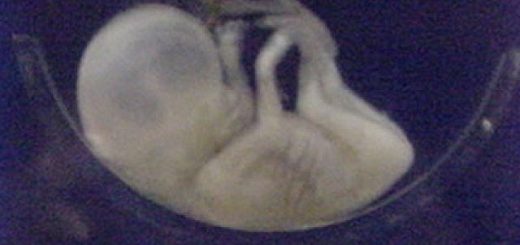Squid Pro Quo

The half-ton squid caught in waters south of New Zealand in February – 33 feet long and weighing 1089 pounds – isn’t kosher, but it can still serve as food for Jewish thought.
Such sea-creatures – this one a representative of the species Mesonychoteuthis hamiltoni – were long thought to be the products of overactive imaginations.
Until 1873, there were only claims, but no hard evidence, that monstrously-sized squids existed. That year, though, a fisherman off the coast of Newfoundland struck a large sea-creature with a hook and then hacked off one of its tentacles. The appendage was later measured to be nineteen feet long. Over subsequent decades, intact carcasses of such giant squids (a smaller species than the “colossal squid” of the recent catch) were discovered washed ashore on various beaches. Thus ended the centuries over which the animal was assumed to be fictional.
Only a few years earlier, though, Arthur Mangin, a celebrated French zoologist, dismissed sailors’ claims that they had seen the animal, urging that:
“the wise, and especially the man of science, not admit into the catalogue those stories which mention extraordinary creatures… the existence of which would be… a contradiction of the great laws of harmony and equilibrium which have sovereign rule over living nature.”
About 700 years before that, the venerated Jewish scholar Maimonides was crafting his powerful literary legacy. Not only a Jewish legal scholar and authority of the first order (whose religious texts are a mainstay of Jewish study to this day), Maimonides was a philosopher and scientist as well. A respected physician, he penned medical texts and served as the official doctor of Saladin, the Sultan of Egypt. Had one not known that Maimonides was the name of a man, a contemporary thinker once wrote, one would naturally assume it was a university.
Among Maimonides’ important works is his commentary on the Mishneh, the foundation of the Talmud. Commenting on the Mishneh’s reference to a bizarre creature – a spontaneously generated rodent – Maimonides wrote:
“…the existence of [such a creature] is something well-known; countless people have told me that they have seen it, even though the existence of such a living creature is incomprehensible and cannot be explained in any way.” [Commentary to the Mishneh, Chullin, chapter 9]
The difference between the reactions of the two scientists, each confronted with a claim that flew in the face of conventional wisdom, is subtle but profound.
Both are compelled to state that the reports before them defy scientific explanation. But whereas Mangin cockily counseled a final rejection of any possibility that the report he received might have merit, Maimonides – even as he notes the inadequacy of scientific knowledge to explain what he has heard – allows for the incomprehensible.
The Talmudic creature could well have been intended as a theoretical construct. There are other references in the Talmud – like one to a “building that flies through the air” – that seem intended as thought-experiments (although, of course, the airplane became entirely real a couple of thousand years later). And Maimonides, famed for his rationalist approach to things, could well have so characterized the rodent case. But, an open-minded thinker first and foremost, he chose instead to simply express the inadequacy of science to explain the claim, allowing for the possibility that the popular lore might nevertheless somehow prove accurate.
That, in fact, is what a true scientist does when evidence doesn’t “seem to fit.” In most cases, an experiment clears up the matter or an observation is conclusively revealed to be flawed. In some, a new mechanism is postulated and demonstrated. And in others, a revolutionary breakthrough – like the discovery of DNA or an idea like relativity or quantum mechanics – turns yesterday’s “science” entirely on its head. And at yet other times, a question mark simply remains.
Spontaneous generation is a discredited notion today (although it is intriguing that contemporary science’s theory of life’s origin is predicated in its own way upon essentially the same thing). But regardless, how Maimonides treated a report of it in his day illustrates how a true scientist never loses the sense of the possible, acknowledges the unknown and maintains always the feeling of wonder that, in the end, leads to discovery.
Scientific hubris – the conviction that contemporary knowledge is ultimate knowledge – is no stranger to contemporary times. And so, in return for providing the recently captured sea-monster our acknowledgment of its existence, the colossal squid has provided us, measure for measure, an invaluable lesson.




Does that mean you belief in aliens, UFOs, and the reincarnation of J.C.? All of above have been claimed to be witnessed by tens of thousands of people. If you don’t, it means you are essentially a skeptic with regard to 99% of people’s claims. Real skeptics (like myself) just go one percent further. It looks like we have more in common than we realize!
But on a more serious note, skepticism is not blind denial of the implausible, but rather a rational weighing of the chance that something ridiculous is factual versus the evidence that it was completely fabricated. And in the overwhelming majority of cases, the latter is true. In fact, the gullible attitude expressed in this article could ch”vsh pave the way for the very same missionaries which we are fighting against.
“The Talmudic creature could well have been intended as a theoretical construct.”
It can’t be explained this way. The gemara says go and look at this creature, and uses it to prove the concept that life can come from dust (for techiyas hameysim).
Dear Moshe Mann,
I think that a true scientist would indeed, prima facie, allow for UFOs and reincarnations, even with his natural skepticism (and, in fact, reincarnations are described in the Gemara as having been effected). If, upon investigation, he found that the claims were inherently faulty (as he likely would), for instance because the testifiers turned out to no be credible, he would suspend that belief. I don’t think that “tens of thousands of people” have laid claim to either of the beliefs you cite (and no, you can’t count Christians who themselves are relying on the testimony of a handful of those who claimed what they claimed). In any event, no supernatural act (as the Rambam himself writes in Hilchos Yesodei HaTorah), even if it actually took place, can prove anything about the “miracle worker.”
I don’t disagree with your definition of valid skepticism, but do disagree that the open-minded attitude of the Rambam bespeaks “gullibility.” No, it bespeaks humility — the sort that we today, in light of strange things like quantum physics and cosmology, would do well to emulate. If you don’t think that stranger things are yet to come in the sciences, you are not a student of science.
Regarding your comment, Kar, I don’t know what gemara you refer to; it is not the one on which the Rambam commented (in Chullin), which deals only with tumah and tahara. If there is indeed a gemara or midrash that says what you cite, I imagine the Rambam would either accept it as describing a truly existent creature, or one that only seems to be what is described, and its appearance is what is to engender the comparison with techias hameisim. But in the tuma/tahara Gemara, I think a theoretical construct could be posited, and that the Rambam’s decision not to take such an approach — as I wrote — is deeply meaningful.
A chag kasher visame’ach to all!
AS
R’ Shafran: To be honest, you should point out that neither the Rambam (who, after all, based his medicine on the four humors- nothing against him, it’s all he had, but we certainly don’t follow his medical advice) nor Mangin (“the great laws of harmony and equilibrium” sound pretty subjective to me) used the rigors of scientific method we use today. There’s nothing in the nature of a giant squid that contradicts what we know about science. To try to use centuries-old claims as a way to say that modern science (at least in its method) is fallible is a bit disingenuous.
Dear Nachum Lamm,
I think both men indeed did use the general approach of the scientific method, although of course you are right that they labored without the benefit of things we know today.
But that was my very (and really only) point. We ourselves, even the scientists among us, labor without the benefit of things yet to be discovered or realized. Noting against us either; it’s all WE have.
But humility about the limitations of what we do know, and realization of the importance of minds open even to the seemingly incredible, are, I think, a healthy prescription for our times.
That is quite true. Wasn’t it Socrates who said something like, “The only wise man is the one who knows that he knows nothing?”
Chag Kasher V’Sameach!
“Regarding your comment, Kar, I don’t know what gemara you refer to; it is not the one on which the Rambam commented (in Chullin), which deals only with tumah and tahara. If there is indeed a gemara or midrash that says what you cite, I imagine the Rambam would either accept it as describing a truly existent creature, or one that only seems to be what is described, and its appearance is what is to engender the comparison with techias hameisim”
It’s sanhedrin 91a. The gemara can’t be allegorized as you suggest.
Chag kasher v’sameach
The reincarnation of J.C.?
Dear Kar,
The reference in that Gemara is part of R’Gamliel’s response to a min. In many such cases, as the Gemara itself notes in various places, the responses are “dichuyin bikash” — i.e. arguments not from fact but from (often mistaken) assumptions.
In any event, all that is needed for the “argument” of R’ Gamliel here is the popular belief that such a creature exists; the Gemara is not (necessarily) establishing its existence as fact.
That said, though, I reiterate my point: the Rambam could have explained the creature cited in Chullin as a theoretical construct (not an allegory), but chose instead to demonstrate the essence of a true scientist: openmindedness to even mind-boggling possibilities.
A Gut Moe’d to you!
AS
A gutten moed,
“The reference in that Gemara is part of R’Gamliel’s response to a min. In many such cases, as the Gemara itself notes in various places, the responses are “dichuyin bikash”—i.e. arguments not from fact but from (often mistaken) assumptions.
In any event, all that is needed for the “argument” of R’ Gamliel here is the popular belief that such a creature exists; the Gemara is not (necessarily) establishing its existence as fact.”
It’s R Ami. I guess, but you are still left with chulin 127a – if it’s a fictional creature, why is the torah being marbe or memaet it? The gemara is discussing whether it’s included in the shratzim or not. You can say this too is theoretical, but there comes a point at which explanations are too strained for the Rambam to have realistically considered them, especially since science was poorly developed in his days and there were lots of phenomena that were unexplained. If the Rambam did think the animal was non-existant, he could easily have said that Chazal mistakenly believed in it; he lived before the Slifkin ban and was under the impression that his shita that Chazal could err was an acceptable belief 🙂 Rambam doesn’t say that he believes in the creature’s existence on Chazal’s say-so alone; he cites many reports that the creature exists , and is willing to dismiss Chazal’s knowledge of the world in other places. That is to say, I think your larger point is moot. Rambam is not being open-minded against known science; he is basing himself on what he considered a scientific data point, the reports of countless people, and merely saying that there is no way then-existing scientific models could account for what he considered confirmed empirical observations.
“That said, though, I reiterate my point: the Rambam could have explained the creature cited in Chullin as a theoretical construct (not an allegory), but chose instead to demonstrate the essence of a true scientist: openmindedness to even mind-boggling possibilities.”
I think not, as above.
Kar
Dear Kar,
I’m not sure I comprehend your words. If, as you say (accurately or not), the Rambam could have dismissed the creature as non-existent (or, as I suggest, as a theoretical construct, like I read a migdal poreiach b’avir) but yet chose not to do that, it would seem to me that he is demonstrating an open mind, which was the point of my essay.
His citation of what “many people” claimed to have seen would make no sense for him to mention were he not allowing for (even with his puzzlement at how such a thing could be) the actual existence of such a creature.
A restful Shabbos and Chag Same’ach to you, and to all CC’s readers!
AS
Dear Roman Catholic,
My apologies. I meant to write “resurrection.” Must have been practicing for the four cups early.
Best,
AS